National symbols of Italy

National symbols of Italy are the symbols that uniquely identify Italy reflecting its history and culture.[2] They are used to represent the Nation through emblems, metaphors, personifications, allegories, which are shared by the entire Italian people.
Some of them are official, i.e. they are recognized by the Italian state authorities, while others are part of the identity of the country without being defined by law.
Description
| Part of a series on the |
| Culture of Italy |
|---|
 |
| People |
| Traditions |
The three main official symbols,[3] whose typology is present in the symbology of all nations, are:
- the Constitution of the Italian Republic;[4]
- the emblem of Italy, that is the iconic symbol identifying the Italian Republic;
- Il Canto degli Italiani by Goffredo Mameli and Michele Novaro, the Italian national anthem, which is performed in all public events.
Of these only the flag is explicitly mentioned in the Italian Constitution; this normative insertion puts the flag under the protection of the law, making it possible criminal penalties for contempt of the same.[5]
Other official symbols, as reported by the Presidency of the Italian Republic,[3] are:
- the Presidential Standard of Italy, that is the distinctive standard representing the Presidency of the Italian Republic;
- the Vittorio Emanuele II of Savoy, the first Sovereign of a united Italy and founder of the Fatherland, which houses the shrine of the Italian tomb of the Unknown Soldier.
- the Festa della Repubblica, that is the national celebratory day established to commemorate the birth of the Italian Republic, which is celebrated every year on 2 June, date of the institutional referendum of 1946 with which the monarchy was abolished;
The teaching in the schools of Il Canto degli Italiani, the reflection on the
There are also other symbols or emblems of Italy which, although not defined by law, are part of the Italian identity:
- the Italia turrita, that is the national personification of Italy in the appearance of a young woman with her head surrounded by a wall crown completed by towers (hence the term "turrita");
- Goddess Roma, the personification of the city of Rome and more broadly, of the ancient Roman state.[8]
- the cockade of Italy, or the national ornament of Italy, obtained by folding a green, white and red ribbon into plissé using the technique called plissage ("pleating");
- the
- the national auto racing colour of Italy is instead rosso corsa ("racing red"), while in other disciplines, such as cycling and winter sports, often use white.
- the national tree because of its green leaves, its white flowers and its red berries, colors that recall the Italian flag;[12]
- the Stella d'Italia, the most ancient identity symbol of Italian land, since it dates back to ancient Greece.[13]
- the Frecce Tricolori, or the national aerobatic team of the Italian Air Force.[14]
Symbols
Altare della Patria
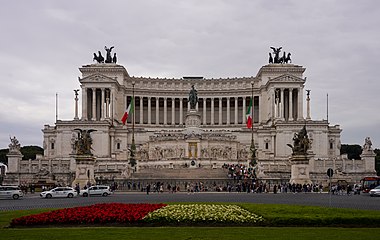
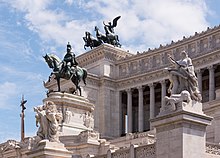
The Vittorio Emanuele II Monument (
From an architectural point of view it was conceived as a modern
It also preserves the Altar of the Fatherland (
Located in the center of ancient Rome and connected to the modern one thanks to streets radiating from Piazza Venezia, it has been consecrated to a wide symbolic value representing - thanks to the call of the figure of Vittorio Emanuele II and the realization of the Altare della Patria - a lay temple metaphorically dedicated to a free and united and celebrating Italy - by virtue of the burial of the Unknown Soldier - the sacrifice for the homeland and for the connected ideals.
Cockade of Italy

The
The Italian tricolour cockade appeared for the first time in Genoa on 21 August 1789,[21] and with it the colours of the three Italian national colours,[21] anticipating by seven years the first tricolour military banner, which was adopted by the Lombard Legion in Milan on 11 October 1796,[22] and of eight years the birth of the flag of Italy, which had its origins on 7 January 1797, when it became for the first time a national flag of an Italian sovereign State, the Cispadane Republic.[23]
The Italian tricolour cockade is one of the symbols of the Italian Air Force, is widely used on all Italian state aircraft, not only military,[24] it is the basis of the parade frieze of the Bersaglieri, cavalry regiments, Carabinieri and Guardia di Finanza,[25][26] and a reproduction of it in fabric is sewn on the shirts of the sports teams holding the Coppa Italia (English: Italy Cup) that are organized in various national team sports.[27] It is tradition, for the most important offices of the State, excluding the President of the Italian Republic, to have a tricolour cockade pinned to their jacket during the military parade of the Festa della Repubblica, which is celebrated every 2 June.[28]
Emblem of Italy
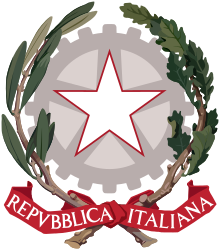
The
The emblem comprises a white
The armorial bearings of the
Festa della Repubblica

The day commemorates the institutional
The ceremonial of the event organized in Rome includes the deposition of a
Flag of Italy
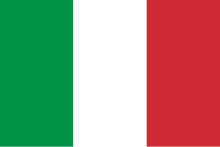
The
The
After 7 January 1797, popular support for the Italian flag grew steadily, until it became one of the most important symbols of the
Frecce Tricolori

The
They were formed in 1961 as an Air Force team, replacing unofficial teams that had been sponsored by various commands by the beginning of the 1930s.[30] The team flies the Aermacchi MB-339-A/PAN, a two-seat fighter-trainer craft capable of 898 km/h at sea level.[30][31] With ten aircraft, nine in training and a soloist, they are the world's largest acrobatics patrol, and their flight schedule, comprising about twenty acrobatics and about half an hour, made them the most famous in the world.[32]
Goddess Roma


In ancient Roman religion, Roma was a female deity who personified the city of Rome and more broadly, the Roman state.[8] She was created and promoted to represent and propagate certain of Rome's ideas about itself, and to justify its rule. She was portrayed on coins, sculptures, architectural designs, and at official games and festivals. In Rome, the Emperor Hadrian built and dedicated a gigantic temple to her as Roma Aeterna ("Eternal Rome"), and to Venus Felix, ("Venus the Bringer of Good Fortune"), emphasising the sacred, universal and eternal nature of the empire.[8] Roma's official cult served to advance the propagandist message of Imperial Rome. In Roman art and coinage, she is usually depicted in military form, with helmet and weapons. In Rome's eastern provinces, she was often shown with mural crown or cornucopia, or both.[33] Her image is rarely found in a commonplace or domestic context.[34] Roma was probably favoured by Rome's high-status Imperial representatives abroad, rather than the Roman populace at large. She was depicted on silver cups, arches, and sculptures, including the base of the column of Antoninus Pius. She survived into the Christian period as a personification of the Roman state. Her depiction seated with a shield and spear later influenced that of Britannia, personification of Britain.
The
The statue of Roma present at the Vittoriano interrupted a custom in vogue until the 19th century, by which the representation of this subject was with exclusively warlike traits. Angelo Zanelli, in his work, decided to further characterize the statue by also providing the reference to
Il Canto degli Italiani
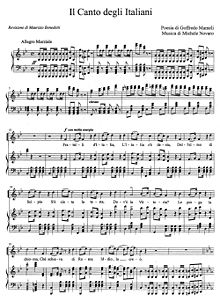
The song was very popular during the unification of Italy and in the following decades, although after the proclamation of the Kingdom of Italy (1861) the Marcia Reale (Royal March), the official hymn of the House of Savoy composed in 1831 by order of King Charles Albert of Sardinia, was chosen as the anthem of the Kingdom of Italy. Il Canto degli Italiani was in fact considered too little conservative with respect to the political situation of the time: Fratelli d'Italia, of clear republican and Jacobin connotation, it was difficult to reconcile with the outcome of the unification of Italy, which was a monarchy.
After the
Italia turrita

Italia turrita, which is one of the national symbols of Italy, has been widely depicted for centuries in the fields of art, politics and literature. Its most classic aspect, which derives from the primordial myth of the
Italian wolf

The
.National colours of Italy

The national colours of Italy are green, white, and red, collectively known in Italian as il Tricolore (English: the Tricolour, Italian: [il trikoˈloːre]). The three Italian national colours appeared for the first time in Genoa on 21 August 1789 on the cockade of Italy shortly after the outbreak of the French Revolution, on 11 October 1796 they were used for the first time in Milan on a military banner, while on 7 January 1797 in Reggio Emilia they appeared for the first time on a flag.
In
The national auto racing colour of Italy is instead rosso corsa ("racing red"), while in other disciplines such as cycling and winter sports, white is often used.
Presidential standard of Italy

The Presidential standard of Italy (Italian: Stendardo presidenziale italiano) is the distinctive standard of the presence of the President of the Italian Republic.
Therefore, it follows the Head of State whenever he leaves the Quirinal Palace, where he is exposed during his presence.[46] The standard is displayed on the means of transport on which the president ascends, outside the prefectures when the president is visiting a city and inside the halls where he acts in an official capacity.[46] The presidential standard is one of the National symbols of Italy.
The standard recalls the colors of the flag of Italy, with particular reference to the standard of the historic Italian Republic of 1802-1805; the square shape and the savoy blue border, whose use was maintained even in the Republican era, symbolize the Italian Armed Forces, which are commanded by the president.[46]
Stella d'Italia
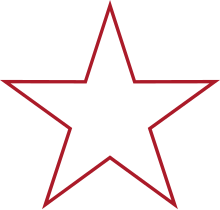
The Stella d'Italia ("Star of Italy"), popularly known as Stellone d'Italia ("Great Star of Italy"),[47] is a five-pointed white star symbolizing Italy for many centuries. It is the oldest national symbol of Italy, since it dates back to ancient Greece[13] when Venus, associated with the West as an evening star, was hired to identify the Italian peninsula. From an allegorical point of view, the Stella d'Italia metaphorically represents the shining destiny of Italy.[48]
In the early 16th century it began to be frequently associated with branch.
Strawberry tree

The
See also
Citations
- strawberry tree, while below is an aquila with spread wings in a laurel wreath.
- ^ "England's National Symbols". england.org.za. Archived from the original on 24 October 2012. Retrieved 18 September 2012.
National symbols are defined as the symbols or icons of a national community (such as England), used to represent that community in a way that unites its people.
- ^ a b "I simboli della Repubblica" (in Italian). Retrieved 8 November 2017.
- ^ [...] The flag of the Republic is the Italian tricolor: green, white and red, with three vertical bands of equal dimensions. [...]
Article No. 12 of the Constitution of the Italian Republic of 27 December 1947, published in the 'Official Journal of the Italian Republic No. 298, Extraordinary Edition, 27 December 1947, and entered into force on 1 January 1948. - ^ Calabrese 2011, p. 109.
- ^ "Legge 23 novembre 2012, n. 222" (in Italian). normattiva.it. Retrieved 30 November 2014.
- ^ "Legge 23 novembre 2012, n. 222" (in Italian). gazzettaufficiale.it. Retrieved 30 November 2014.
- ^ ISBN 3-11-010389-3.
- ^ a b Livy (1797). The history of Rome. George Baker (trans.). Printed for A. Strahan.
- ^ ISBN 9780313344978.
- ^ a b Blashfield, Jean F. (2009). Italy. Scholastic. p. 33.
- ^ a b c "Il corbezzolo simbolo dell'Unità d'Italia. Una specie che resiste agli incendi" (in Italian). altovastese.it. Retrieved 25 January 2016.
- ^ a b Rossi 2014, p. 38.
- ^ "I 60 anni delle Frecce Tricolori: simbolo e orgoglio dell'Italia nel mondo" (in Italian). Retrieved 21 August 2022.
- .
- ^ "I SIMBOLI DELLA REPUBBLICA - IL VITTORIANO".
- ^ "La Coccarda alla Biblioteca Museo Risorgimento" (in Italian). Retrieved 7 May 2017.
- ^ "Renata Polverini: coccarde tricolori alla sua giunta ma i colori sono invertiti – Il Messaggero" (in Italian). Retrieved 6 May 2017.
- ^ Barbero 2015, chapt. XVIII.
- ^ "Le origini della bandiera italiana" (in Italian). Retrieved 14 August 2018.
- ^ a b Ferorelli, Nicola (1925). "La vera origine del tricolore italiano". Rassegna Storica del Risorgimento (in Italian). XII (fasc. III): 662.
- ^ "L'Esercito del primo Tricolore" (PDF) (in Italian). Archived from the original (PDF) on 9 March 2017. Retrieved 8 March 2017.
- ^ "I simboli della Repubblica" (PDF) (in Italian). Archived from the original (PDF) on 6 October 2015. Retrieved 7 May 2017.
- ^ "San Felice, escursionista di Gaeta ferito mentre scende dal Picco di Circe" (in Italian). Retrieved 21 August 2018.
- ^ "I cento anni del nostro fregio" (PDF) (in Italian). Retrieved 20 August 2018.
- ^ "Il cappello piumato". Archived from the original on 13 March 2017. Retrieved 13 August 2018.
- ^ "Quando scudetto e coccarda sono sulla stessa maglia..." (in Italian). Retrieved 1 May 2012.
- ^ "2 giugno, gli applausi per Mattarella e Conte all'Altare della Patria" (in Italian). Retrieved 2 June 2018.
- ^ Costituzione della Repubblica Italiana Art. 12, 22 dicembre 1947, pubblicata nella Gazzetta Ufficiale n. 298 del 27 dicembre 1947 edizione straordinaria (published in the Official Gazette [of the Italian Republic] No. 298 of 27 December 1947 extraordinary edition) "La bandiera della Repubblica è il tricolore italiano: verde, bianco, e rosso, a tre bande verticali di eguali dimensioni"
- ^ a b Aeronautica Militare official site
- ^ Caliaro 2005, p. 25
- ^ Caliaro 2005, p. 25.
- ISBN 3-11-010389-3.
- JSTOR 44981971.
- ^ OCLC 742504798.
- ^ a b "L'Altare della Patria" (in Italian). Archived from the original on 1 January 2018. Retrieved 1 January 2018.
- ISBN 978-88-272-2498-4.
- ^ "Ministero della Difesa – Il Vittoriano". www.difesa.it (in Italian). Archived from the original on 14 July 2014. Retrieved 14 November 2018.
- ^ John Agnew, The Impossible Capital: Monumental Rome under Liberal and Fascist Regimes, 1870–1943, Wiley Blackwell, 2005
- ^ (in Italian) DOP entry .
- ^ "Italy – Il Canto degli Italiani/Fratelli d'Italia". NationalAnthems.me. Retrieved 24 November 2011.
- ^ Rome, Wanted in (2019-08-09). "Wolves get close to centre of Rome". Wanted in Rome. Retrieved 2020-03-20.
- ^ (in French) Monnier, A. & Figuet, R. (May 2013), Le loup en France Plan national d'action sur le loup 2008-2012, CGAAER 78
- .
- .
- ^ a b c "Lo Stendardo presidenziale" (in Italian). Retrieved 22 September 2010.
- ^ "I simboli della Repubblica – L'emblema" (in Italian). Retrieved 2 February 2016.
- ^ Bazzano 2011, p. 7.
- ^ (in Italian) various authors - Guida pratica agli alberi e arbusti in Italia; Biblioteca per chi ama la natura - Selezione dal Reader's Digest Milano 1983, 1991.
References
- Barbero, Alessandro (2015). Il divano di Istanbul (in Italian). Sellerio Editore. ISBN 978-88-389-3352-3.
- Bazzano, Nicoletta (2011). Donna Italia. L'allegoria della Penisola dall'antichità ai giorni nostri (in Italian). Angelo Colla Editore. ISBN 978-88-96817-06-3.
- Calabrese, Michele (2011). "Il Canto degli Italiani: genesi e peripezie di un inno". Quaderni del Bobbio (in Italian). 3.
- Luigino, Caliaro (2005). "Frecce Tricolori". Pattuglie acrobatiche. ISBN 88-8058-873-7.
- Rossi, Girolamo (2014). Lo scudo crociato. Un simbolo medievale nella comunicazione politica del Novecento (in Italian). Armando Editore. ISBN 9788866774198.
External links
- (in Italian) Ecco alcuni simboli italiani!
